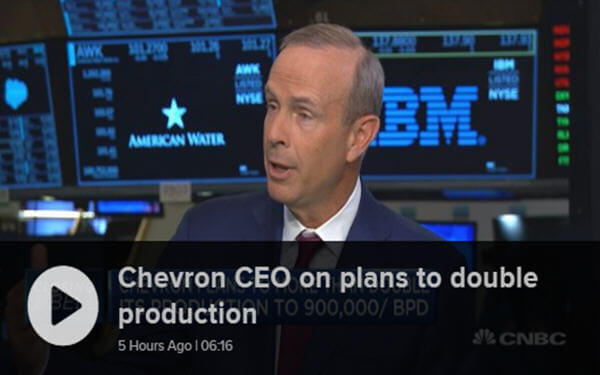
Exxon Mobil and Chevron on Tuesday said they both plan to surge oil and natural gas output from America’s top shale field in the coming years, a strategy that the energy giants say will yield significant returns.
As early as 2024, Exxon believes it can increase output from the Permian Basin to 1 million barrels per day of oil equivalent, a measure that blends crude oil and gas production. That represents an 80 -percent increase, the company said in a news release a day ahead of its meeting with investors.
Meanwhile, Chevron aims to more than double its oil and gas output to 900,000 boepd by the end of 2023. Chevron sees Permian production hitting 600,000 boepd by the end of next year, the company said at its meeting with analysts on Tuesday.
The Permian is the epicenter of the U.S. shale boom, which has made the nation the world’s top producer of oil and natural gas. Drillers in the region underlying western Texas and southeastern New Mexico use advanced techniques like hydraulic fracturing to coax oil and gas from shale rock formations.
Once the domain of independent frackers, the shale drilling process is being industrialized by large international oil companies. The oil majors are stitching together large swaths of land and drilling multiple horizontal wells from a single location, making the expensive method more efficient.
“The big thing that I think has changed is the shale game has become a scale game, and so people that can do things at large scale and bring the capabilities to bear that a company like Chevron has are the ones that really can take this to the next level,” Chevron Chairman and CEO Michael Wirth told CNBC’s “Closing Bell” on Tuesday.
Chevron’s output from the Permian hit 377,000 boepd last quarter, an 84 percent increase from a year ago. The company says it plans $19 to $22 billion in capital spending per year from 2021 to 2023.
“Our message to our investors was it’s a good time to be Chevron. Our portfolio is stronger than it’s ever been, and you don’t have to look any further than the Permian to see that,” Wirth said. “We’re delivering strong production with low risk and disciplined spending, which leaves plenty of money to be returned to shareholders.”
Exxon’s Permian production surged 93 percent in the final quarter of 2018 from the year-ago period.
“We’re increasingly confident about our Permian growth strategy due to our unique development plans,” Neil Chapman, senior vice president at Exxon, said in a statement. “We will leverage our large, contiguous acreage position, our improved understanding of the resource and the full range of ExxonMobil’s capabilities in executing major projects.”
Exxon says its Permian assets can produce healthy returns even during times of low oil prices. If crude futures fall to $35 a barrel, Exxon says returns from its Permian assets will still average 10 percent.
Permian Basin oil production is expected to top 4 million barrels per day this month. That is about a third of total U.S. output, which is sitting at a record just above 12 million bpd, according to preliminary government figures.
Output from the region has been constrained by a lack of pipelines needed to carry crude from oil fields to refineries and export terminals. Analysts expect the industry to bring new infrastructure online and clear the bottlenecks by the end of the year.
Exxon is investing heavily in the Permian and U.S. Gulf Coast, with construction planned or under way at 30 sites to account for growth in oil and gas processing and water handling and to assure there’s enough infrastructure to move fossil fuel around the region.
Earlier this year, Chevron announced it would buy Pasadena Refining System from Brazil’s Petrobras for $350 million. The deal will give Chevron control of a Pasadena, Texas, refinery, its first processing facility in the Houston area and a means of processing its growing Permian output.
Source: CNBC